Last updated: October 24, 2024
Article
Climate and Water Monitoring at Chiricahua National Monument: Water Year 2021

Storm over Chiricahua National Monument. NPS/M. Cahill
Overview
Together, climate and hydrology shape ecosystems and the services they provide, particularly in arid and semi-arid ecosystems. Understanding changes in climate, groundwater, and surface water is key to assessing the condition of park natural resources—and often, cultural resources.
At Chiricahua National Monument (NM), Sonoran Desert Network (SODN) scientists study how ecosystems may be changing by taking measurements of key resources, or “vital signs” year after year, much as a doctor keeps track of a patient’s vital signs. This long-term ecological monitoring provides early warning of potential problems, allowing managers to mitigate them before they become worse. At Chiricahua, we monitor climate, weather, groundwater, and springs among other vital signs.
Surface-water and groundwater conditions are closely related to climate conditions. Because they are better understood together, we report on climate in conjunction with water resources. Reporting is by water year (WY), which begins in October of one calendar year and goes through September of the next (e.g., WY2021 runs from October 2020 through September 2021).
This article reports the results of climate and water monitoring done at Chiricahua National Monument (Figure 1) in water year 2021.

Figure 1. Monitored weather station and groundwater wells at Chiricahua National Monument.
Climate and Weather
There is often confusion over the terms, “weather” and “climate.” In short, weather describes instantaneous meteorological conditions (e.g., it's currently raining or snowing, it’s a hot or frigid day). Climate reflects patterns of weather at a given place over longer periods of time (seasons to years). Climate is the primary driver of ecological processes on earth. Climate and weather information provide context for understanding the status or condition of other park resources.
Methods
A Remote Automated Weather Station (RAWS), Chiricahua Arizona #021409, has been in operation at Chiricahua NM since 1995 (see Figure 1). This station provides a reliable, climate dataset used for analyses in this climate and water report. Data from this station is accessible through the Climate Analyzer.
Results for Water Year 2021
Precipitation
Annual precipitation at Chiricahua NM in WY2021 was 15.64" (39.7 cm), 0.67" (1.7 cm) less than the 1995–2020 annual average. During the monsoon season (July–September), precipitation measured 12.02" (30.5 cm), which was substantially more than the 1995–2020 average (9.67", 24.6 cm; Figure 2). Rainfall during all other months was near or below the averages for 1995–2020. Extreme daily rainfall events (≥1"; 2.54 cm) occurred on one day, fewer than the annual frequency for 1995–2020 (2.8 days). The largest daily rainfall event was 1.54", on August 13, 2021.
Air temperature
The mean annual maximum air temperature at Chiricahua NM in WY2021 was 74.6°F (23.7°C), which was slightly warmer than the 1995–2020 average maximum by 0.2°F (0.1°C). The mean annual minimum air temperature in WY2021 was 48.4°F (9.1°C), 0.7F (0.4°C) warmer than the 1995–2020 average minimum. Extremely hot temperatures (>94°F; 34.4°C) occurred on 15 days, fewer than the annual frequency for 1995–2020 (22.7). Extremely cold temperatures (<28°F; −2.2°C) occurred on 23 days, the same as the annual frequency for 1995–2020 (22.6 days).

Figure 2. Climogram showing monthly precipitation and mean maximum and minimum temperature, WY2021, Chiricahua National Monument. Data source: climateanalyzer.org
Drought
Reconnaissance drought index (Tsakiris and Vangelis 2005) provides a measure of drought severity and extent relative to the long-term climate. It is based on the ratio of average precipitation to average potential evapotranspiration (the amount of water loss that would occur due to evaporation and plant transpiration if the water supply was unlimited) over short periods of time (seasons to years). The reconnaissance drought index for Chiricahua NM indicates WY2021 was somewhat drier than the 1996–2021 average, from the perspective of both precipitation and potential evapotranspiration (Figure 3).

Figure 3. Reconnaissance drought index for Chiricahua National Monument, WY1996–2021. “N/A” = insufficient data to generate reliable estimates. Drought index calculations are relative to the time period selected: 1995–2021. Choosing a different set of start/end points may produce different results. Data source: climateanalyzer.org
Groundwater
Groundwater is one of the most critical natural resources of the American Southwest, providing drinking water, irrigating crops, and sustaining rivers, streams, and springs throughout the region.
Methods
Groundwater at Chiricahua NM is monitored using three wells (see Figure 1). The Campground-1 and Headquarters wells are monitored monthly by monument staff. The Faraway Ranch well was monitored by monument staff until 2016, when the Arizona Department of Water Resources (ADWR) began continuous monitoring. ADWR data is available at the ADWR Well Registry Search.
Results for Water Year 2021
Due to safety concerns, groundwater measurements at Campground-1 ceased in early WY2021, so average water levels for that well are not representative of the entire year. Groundwater monitoring at Campground-1 is expected to restart after a new well house is constructed. Many measurements made at Campground-1 may not represent static conditions due to pumping at a nearby well.
Average water levels in all three wells were lower than in the previous year (Table 1). The lowest water level recorded at Faraway Ranch (17.59 ft/5.36 m below ground surface) occurred in July 2021, but water levels quickly rebounded following monsoon storms. Overall, water levels in the three wells have been stable, with seasonal variability caused by runoff events in Bonita Creek. Water levels at the three wells have only varied 5.42–8.49 feet (1.65–2.59 m) over the monitoring period (Figure 4).
Table 1. Groundwater monitoring results for Chiricahua National Monument, water year 2021.
| Name | State well number | Wellhead elevation (feet amsl)* | Average depth to water (feet bgs)** | Average water level elevation (feet amsl)* | Change in elevation from WY2020 (± feet) |
|---|---|---|---|---|---|
| Campground-1 | 629082 | 5,340.50 | 24.68 | 5,315.82 | −4.09 |
| Headquarters | 629081 | 5,256.00 | 10.62 | 5,245.38 | −0.90 |
| Faraway Ranch | 629083 | 5,216.13 | 16.32 | 5,199.80 | −2.47 |
*amsl = above mean sea level; **bgs = below ground surface
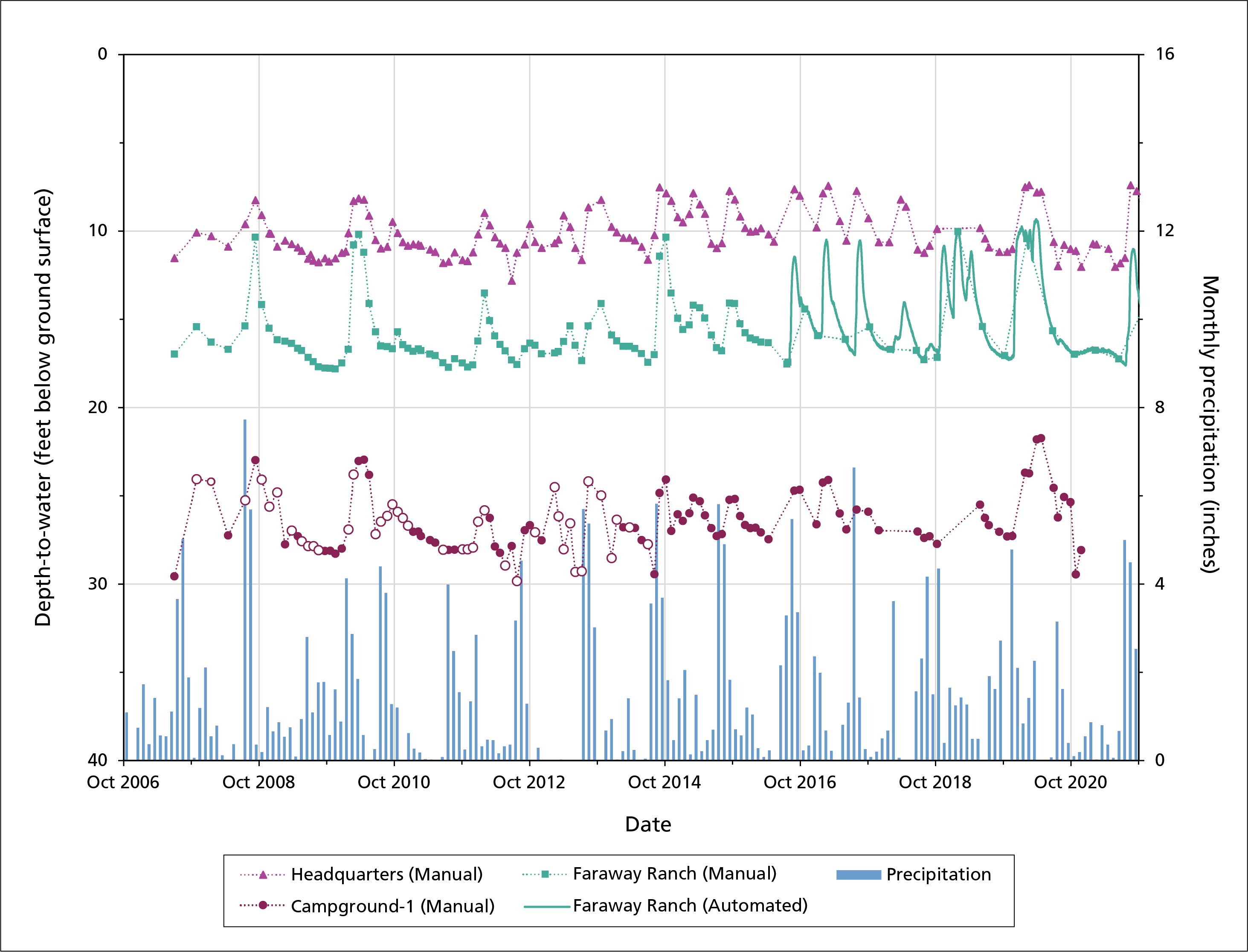
Figure 4. Depth-to-water (feet below ground surface) at three groundwater monitoring wells and monthly precipitation from the Remote Automated Weather Station at Chiricahua National Monument, water years 2007–2021. White circles indicate manual measurements collected when the well was being pumping or recently pumped.
Springs
Background
Springs, seeps, and tinajas (small pools in a rock basin or impoundments in bedrock) are small, relatively rare biodiversity hotspots in arid lands. They are the primary connection between groundwater and surface water and are important water sources for plants and animals. For springs, the most important questions we ask are about persistence (How long was there water in the spring?) and water quantity (How much water was in the spring?).
Sonoran Desert Network springs monitoring is organized into four modules, described below.
Site characterization
This module, which includes recording GPS locations and drawing a site diagram, provides context for interpreting change in the other modules. We also describe the spring type (e.g., helocrene, limnocrene, rheocrene, or tinaja) and its associated vegetation. Helocrene springs emerge as low-gradient wetlands. Limnocrene springs emerge as pools, and rheocrene springs emerge as flowing streams. This module is completed once every five years or after significant events.
Site condition
We estimate natural and anthropogenic disturbances and the level of stress on vegetation and soils on a scale of 1–4, where 1 = undisturbed, 2 = slightly disturbed, 3 = moderately disturbed, and 4 = highly disturbed. Types of natural disturbances can include flooding, drying, fire, wildlife impacts, windthrow of trees and shrubs, beaver activity, and insect infestations. Anthropogenic disturbances can include roads and off-highway vehicle trails, hiking trails, livestock and feral-animal impacts, removal of invasive non-native plants, flow modification, and evidence of human use. We take repeat photographs showing the spring and its landscape context. We note the presence of certain obligate wetland plants (plants that almost always occur only in wetlands), facultative wetland plants (plants that usually occur in wetlands, but also occur in other habitats), and non-native bullfrogs and crayfish, and we record the density of invasive, non-native plants.
Water quantity
We measure the persistence of surface water, amount of spring discharge, and wetted extent. To estimate persistence, we analyze the variance of temperature measurements taken by logging thermometers placed at or near the orifice (spring opening). Because water mediates variation in diurnal temperatures, data from a submerged sensor will show less daily variation than data from an exposed open-air sensor; this tells us when the spring was wet or dry. Surface discharge is measured with a timed sample of water volume. Wetted extent is a systematic measurement of the physical length (up to 100 m), width, and depth of surface water. It is assessed using a technique for either standing water (e.g., limnocrene and helocrene springs) or flowing water (e.g., rheocrene springs).
Water quality
We measure core water-quality parameters and water chemistry. Core parameters include water temperature, pH, specific conductivity (a measure of dissolved compounds and contaminants), dissolved oxygen (how much oxygen is present in the water), and total dissolved solids (an indicator of potentially undesirable compounds). Discrete samples of these parameters are collected with a multiparameter meter. If the meter failed calibration check(s), we do not present data. Water chemistry is assessed by collecting surface water sample(s) and estimating the concentration of major ions with a photometer in the field. These parameters are collected at one or more sampling locations within a spring. Data are presented only for the primary sampling location.Each perennial spring is somewhat unique, and there are not water-quality standards specific to most perennial springs in Arizona. Where conditions exceed water-quality standards for other surface waters (rivers, streams, lakes, and reservoirs), we note it, but the reader is advised that these standards were not developed for perennial springs. Our ongoing data collection at each spring will improve our understanding of the natural range in water-quality and water-chemistry parameters for a given site.
Results for Water Year 2021
Garfield Spring | Newton Cave Seep | Shake Spring | Silver Spur Spring
Garfield Spring
Garfield Spring (Figure 5) is a rheocrene spring (emerges as a flowing stream) on a north-facing slope. When characterized in WY2017, Orifice A emerged as a small pool adjacent to a tree-root overhang. The pool immediately transitioned to a narrow, intermittent springbrook with cool, clear water.
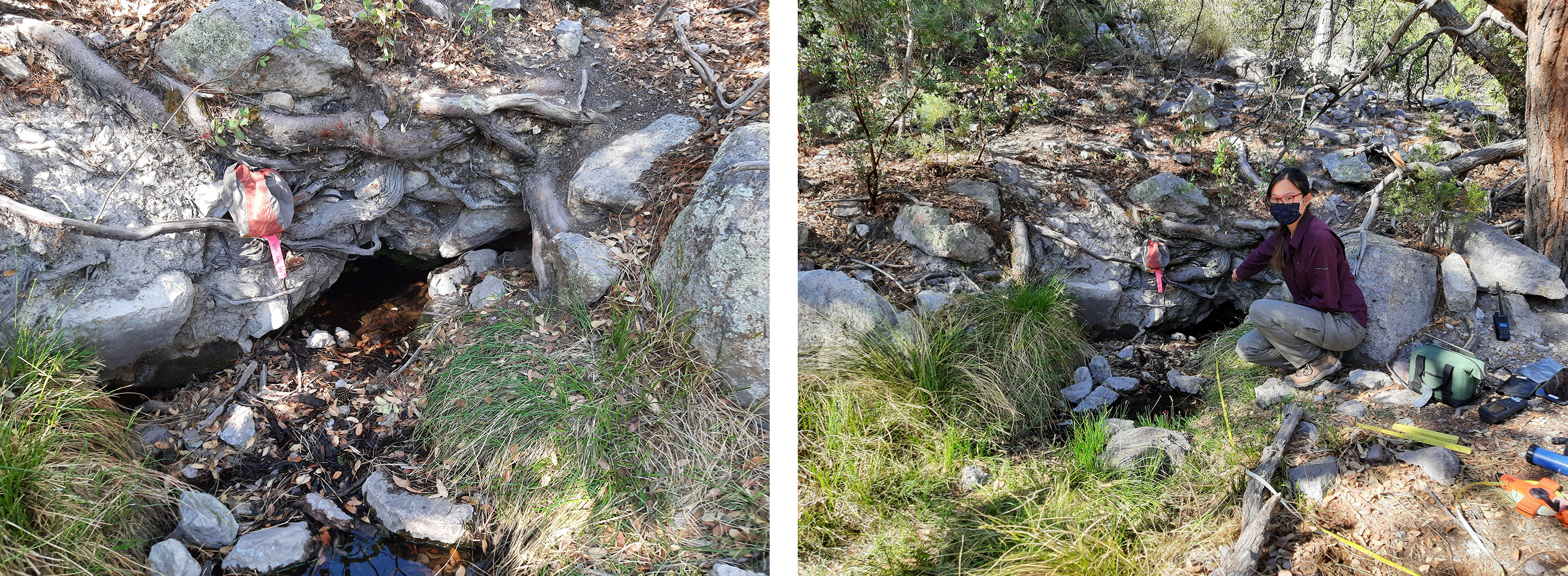
Figure 5. Left: Garfield Spring orifice. Right: Below the orifice, the Garfield Spring springbrook supports sedges and grasses. NPS photos from April 2021.
Site condition. As in past years, the crew recorded slight disturbance from the impact of hiking trails in WY2021, due to the well-used path that leads directly to the spring. Also as seen in past years, use by wildlife also was rated as “slightly disturbed” due to digging in the spring orifice and tracks, trampling, and scat found around the site. Impacts from a new (in 2021) wildlife-camera study at the site resulted in “slightly disturbed” ratings for contemporary human use and other human use due to the presence of the cameras, as well as some vegetation clearing and trampling for camera access. All other natural and human-caused disturbance types were rated as “undisturbed.”
The crew did not observe crayfish or bullfrogs (non-native, invasive aquatic animals), nor did they observe any non-native invasive plants. The crew observed the obligate, wetland sedge (Carex sp.), as in 2018 and 2019.
 Figure 6. Water persistence in Garfield Spring, Chiricahua National Monument.
Figure 6. Water persistence in Garfield Spring, Chiricahua National Monument.Water quantity. The WY2021 visit occurred on April 20, 2021. The spring contained water when sampled. Temperature sensors indicated that Garfield Spring was wetted (contained water) for all 176 days (100%) measured up to the WY2021 visit, with some missing data at the start of the water year (Figure 6). In prior water years, the spring was wetted 99.5–100% of the days measured.
Discharge was estimated at 0.6 (± 0.1) liters (0.1 ± 0.03 gal) per minute in WY2021. This was comparable to previous measurements at Garfield Spring during the sampling period (Table 2).
Wetted extent was evaluated using a method for flowing water. The total brook length was 25 meters (82 ft), which was substantially less than in previous years (2017–2019) (Table 3). Width and depth averaged 38 centimeters (15 in) and 0.3 centimeters (0.1 in), respectively. Wetted width was comparable to past years, but depth was on the lower edge of the observed range.
Water quality. Core water-quality (Table 4) and water-chemistry data were collected at the primary sampling location. The values were within the range recorded in prior years (accounting for the precision of our instruments), with the exception of chloride, which was slightly higher than previously observed (Table 5).
Table 2. Discharge data (L/min; mean ± SD) for Garfield Spring in water year 2021, and a range of values from prior years./p>
| Sampling location | WY2021 value (Range of prior values) | Prior years measured (# of measurements) |
|---|---|---|
| 002 | 0.6 ± 0.1 (0.3–0.5) | 2017–2019 (3) |
Table 3. Average (± SD) width and depth (cm) of Garfield Spring within springbrook length (up to 100 m) in water year 2021, and a range of values from prior years.
| Measurement | WY2021 value (Range of prior values) | Prior years measured (# of measurements) |
|---|---|---|
| Width (cm) | 38 ± 27.3 (28.1–47.9) | 2017–2019 (3) |
| Depth (cm) | 0.3 ± 0.1 (0.5–0.8) | 2017–2019 (3) |
| Length (m) | 24.9 (35.9–37.5) | 2017–2019 (3) |
Table 4. Data on core water-quality parameters for Garfield Spring in water year 2021, and a range of values from prior years.
| Parameter | Sampling location | Measurement location | WY2021 value (Range of prior values) |
Prior years measured (# of measurements) |
|---|---|---|---|---|
| Dissolved oxygen (mg/L) | 001 | Center | 5.51 (2.73–4.3) | 2017–2019 (3) |
| pH | 001 | Center | 7.1 (6.96–7.88) | 2017–2019 (3) |
| Specific conductivity (µS/cm) | 001 | Center | 182.2 (184.6–188.1) | 2017–2019 (3) |
| Temperature (°C) | 001 | Center | 12.7 (11.9–14.3) | 2017–2019 (4) |
| Total dissolved solids (mg/L) | 001 | Center | 118 (119.6–122.2) | 2017–2019 (3) |
Table 5. Water-chemistry data (mg/L) for Garfield Spring in water year 2021, and a range of values from prior years.
| Parameter | Sampling location | Measurement location | WY2021 value (Range of prior values) |
Prior years measured (# of measurements) |
|---|---|---|---|---|
| Alkalinity (CaCO3) | 001 | Center | 70 (60–80) | 2017–2019 (3) |
| Calcium (Ca) | 001 | Center | 18 (16) | 2017–2019 (3) |
| Chloride (Cl) | 001 | Center | 10 (3–5) | 2017–2019 (3) |
| Magnesium (Mg) | 001 | Center | 6 (7–11) | 2017–2019 (3) |
| Potassium (K) | 001 | Center | 2.2 (1.4–1.8) | 2017–2019 (3) |
| Sulphate (SO4 ) | 001 | Center | 3 (0–4) | 2017–2019 (3) |
Newton Cave Seep
Newton Cave Seep emerges at the base of an east-facing cliff (Figure 7). When characterized in WY2017, its spring type was not certain. There was an approximately 1 × 2 × 5-meter (0.3 × 6.6 × 16.4-foot) overhang above substrate of primarily sand and small gravel. The orifice itself was a small area of moist sand, with moss lining the bedrock wall. Directly out from the orifice, there were a few oak trees that were noticeably greener and denser than the surrounding upland community.

Figure 7. Newton Cave Seep, April 2021. NPS photo.
Site condition. When visited in WY2021, Newton Cave Seep was reduced to a five-centimeter patch of saturated soil: a “highly disturbed” condition due to drying that was more extreme than in past years (though this spring has often been rated as “disturbed” due to persistent drying). Oaks and other nearby vegetation are typically greener and more vigorous near the seep, but in WY2021, this vegetation was consistent with the surrounding landscape. Scat and tracks indicated a “slightly disturbed” impact from wildlife use, as in past years. All other natural and human-caused disturbances were rated as “undisturbed” in WY2021.
As in previous years, the crew did not observe crayfish or bullfrogs (non-native, invasive aquatic animals), nor did they detect any non-native, invasive plants. No obligate or facultative wetland plants were observed at Newton Cave Seep during sampling in WY2021, as in prior years.
 Figure 8. Water persistence in Newton Cave Seep, Chiricahua National Monument.
Figure 8. Water persistence in Newton Cave Seep, Chiricahua National Monument.Water quantity. The WY2021 visit occurred on April 19, 2021. The spring was wetted (saturated soil). Temperature sensors indicated that Newton Cave Seep was wetted (contained water) for 174 of 174 days (100%) measured up to the WY2021 visit (Figure 8). In prior water years, the spring was wetted 100% of the days measured. These estimates are likely influenced by the overhanging cliff.
As in past years, there was no discharge at Newton Cave Seep during the sampling period. Wetted extent was not measured, as there was no surface water—just a five-centimeter patch of saturated soil.
Water quality. As in past years, core water-quality and water-chemistry data could not be collected, as no surface water was present during the sampling period.
Shake Spring
Shake Spring (Figure 9) was characterized in WY2017 as a rheocrene spring (emerges as a flowing stream) situated in a west-facing drainage in Bonita Canyon. Orifice A occurred under underneath a car-sized boulder approximately five meters (16.5 ft) from the spring box. The small springbrook was braided throughout the channel.
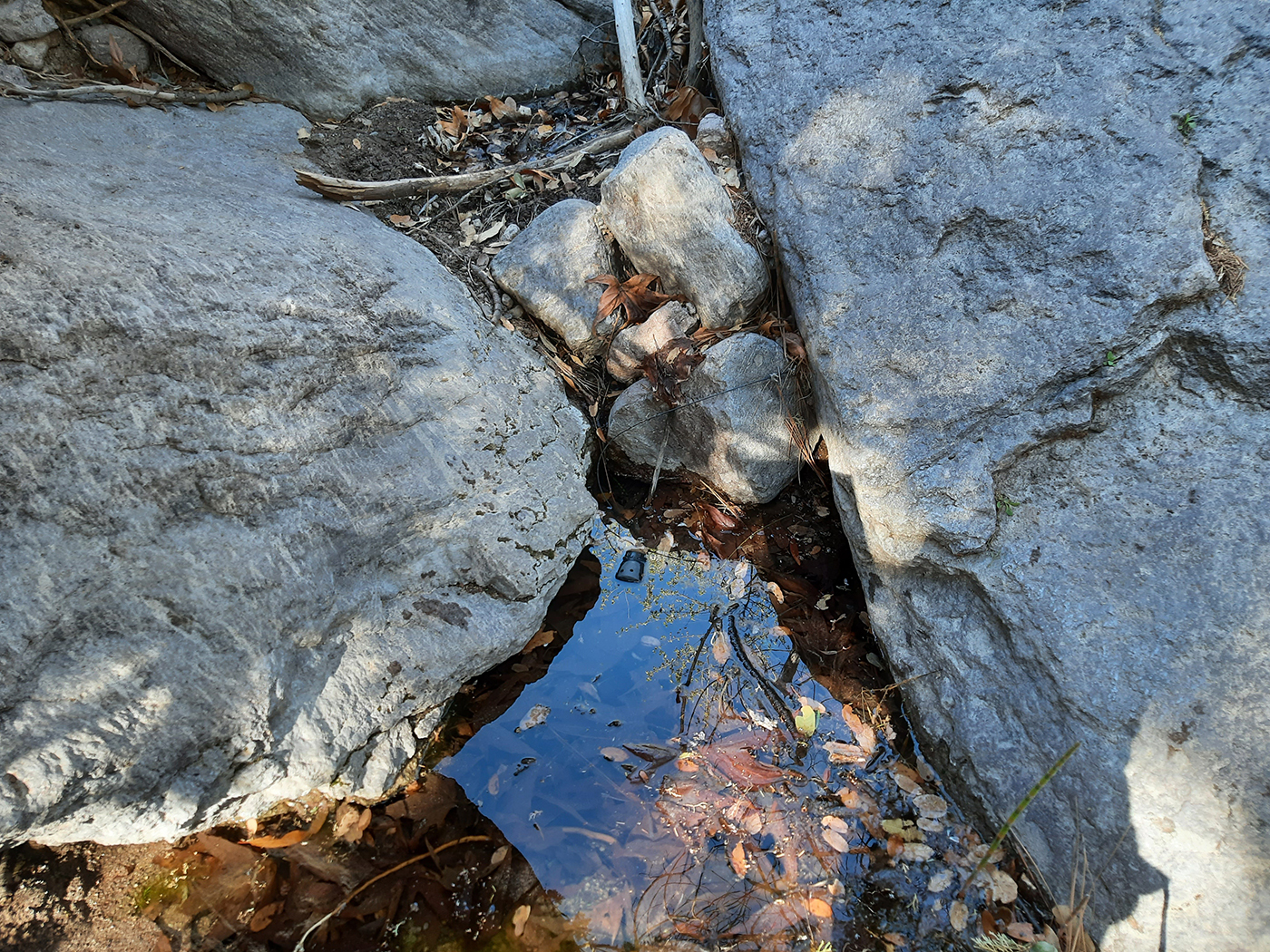
Figure 9. Shake Spring, April 2021. NPS photo.
Site condition. As in past years, the crew rated anthropogenic disturbance as “moderately disturbed,” due to the impact of the springbox and concrete pad. Wildlife disturbance in the form of vegetation trampling and tracks was rated as “slightly disturbed” for the first time in WY2021. All other disturbance factors were rated as “undisturbed,” as in prior years.
The crew did not observe crayfish or bullfrogs (non-native, invasive aquatic animals). However, we did detect one non-native plant, common mullein (Verbascum thapsus), at very low density (1–5 plants), as in past years. We also observed several obligate/facultative native wetland genera and families: the forbs, horsetail (Equisetum sp.) and monkeyflower (Mimulus sp.); sedges (Carex sp. and Cyperacacea family); and the trees, sycamore (Platanus sp.) and willow (Salix sp.). We have observed all these wetland plants at Shake Spring in prior years.
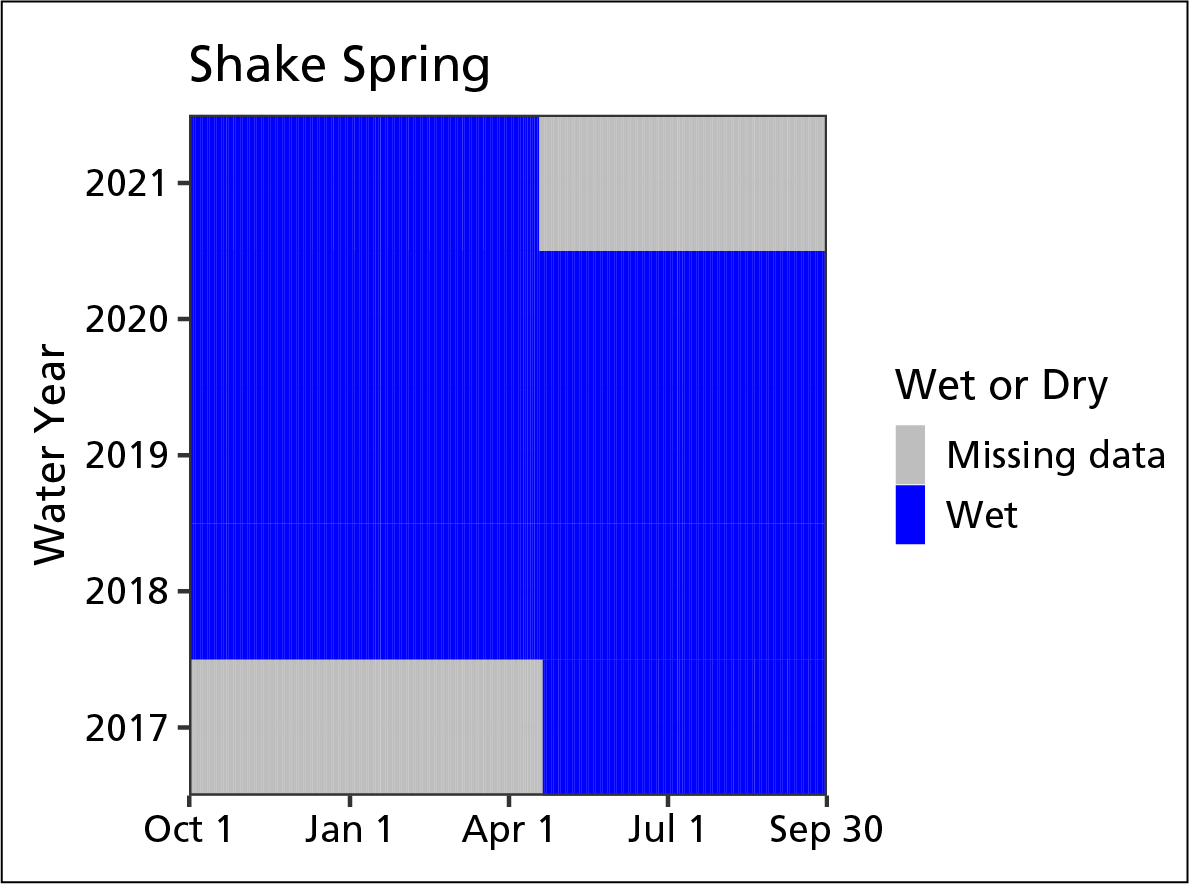 Figure 10. Water persistence in Shake Spring, Chiricahua National Monument.
Figure 10. Water persistence in Shake Spring, Chiricahua National Monument.Water quantity. The WY2021 visit occurred on April 19, 2021. The spring contained water at the time of the visit. Temperature sensors indicated that Shake Spring was wetted (contained water) for 201 days (100%) measured up to the WY2021 visit (Figure 10). In prior water years, the spring was wetted 100% of the days measured.
Discharge was estimated at 7.5 (± 0.1) liters (2 ± 0.03 gal) per minute in WY2021 (Table 6). This was within the range observed in past years (see Table 6). Wetted extent was evaluated using a method for flowing water. The total brook length was 31 meters (102 ft). Width and depth averaged 82.2 centimeters (32.4 in) and 8.5 centimeters (3.3 in), respectively. Width and depth were comparable to that seen in past years. However, the springbrook length was only about 30–40% of that observed in past years (Table 7).
Water quality. Core water-quality and water-chemistry data were collected at the Shake Spring orifice, as in past years. Most values were within the ranges previously observed, with a few notable exceptions. Dissolved oxygen was slightly lower than observed in the past (Table 8). Magnesium and sulfate were much lower than had ever been previously observed, and alkalinity was much higher than in 2017–2019 (Table 9).
Table 6. Discharge data (L/min; mean ± SD) for Shake Spring in water year 2021, and a range of values from prior years.
| Sampling location | WY2021 value (Range of prior values) | Prior years measured (# of measurements) |
|---|---|---|
| 001 | 7.5 ± 0.1 (5.7–12.8) | 2017–2019 (3) |
Table 7. Average (± SD) width and depth (cm) of Shake Spring within springbrook length (up to 100 m) in water year 2021, and a range of values from prior years.
| Measurement | WY2021 value (Range of prior values) | Prior years measured (# of measurements) |
|---|---|---|
| Width (cm) | 82.2 ± 63.6 (56.1–95) | 2017–2019 (3) |
| Depth (cm) | 8.5 ± 7.5 (2.5–6.1) | 2017–2019 (3) |
| Length (m) | 30.9 (78.5–92.8) | 2017–2019 (3) |
Table 8. Data on core water-quality parameters for Shake Spring in water year 2021, and a range of values from prior years.
| Parameter | Sampling location | Measurement location | WY2021 value (Range of prior values) |
Prior years measured (# of measurements) |
|---|---|---|---|---|
| Dissolved oxygen (mg/L) | 001 | Center | 5.98 (6.42–6.49) | 2017–2019 (3) |
| pH | 001 | Center | 7.52 (7.12–7.56) | 2017–2019 (3) |
| Specific conductivity (µS/cm) | 001 | Center | 364.7 (353.7–366.3) | 2017–2019 (3) |
| Temperature (°C) | 001 | Center | 13.4 (13–14.8) | 2017–2019 (4) |
| Total dissolved solids (mg/L) | 001 | Center | 237 (230.1–237.9) | 2017–2019 (3) |
Table 9. Water-chemistry data (mg/L) for Shake Spring in water year 2021, and a range of values from prior years.
| Parameter | Sampling location | Measurement location | WY2021 value (Range of prior values) |
Prior years measured (# of measurements) |
|---|---|---|---|---|
| Alkalinity (CaCO3) | 001 | Center | 170 (135) | 2017–2019 (3) |
| Calcium (Ca) | 001 | Center | 50 (42–50) | 2017–2019 (3) |
| Chloride (Cl) | 001 | Center | 5 (5–56) | 2017–2019 (3) |
| Magnesium (Mg) | 001 | Center | 1 (7–13) | 2017–2019 (3) |
| Potassium (K) | 001 | Center | 1.2 (0.8–1.6) | 2017–2019 (3) |
| Sulphate (SO4) | 001 | Center | 2 (19–32) | 2017–2019 (3) |
Silver Spur Spring
Silver Spur Spring (Figure 11) was characterized in WY2017 as a rheocrene spring (emerges as a flowing stream) in the channel of lower Bonita Canyon. The springbrook was occasionally braided, but largely a single channel. The substrate was dominated by a mix of sand, gravel, cobble, and boulders.

Figure 11. Left: Silver Spur Spring. Right: Silver Spur springbrook. NPS photos from April 2021.
Site condition. The crew rated contemporary human use, hiking trails and wildlife as “slightly disturbed,” as there was evidence of human and wildlife tracks and trampling when visited in WY2021. This was consistent with past observations. A well-used hiking trail leads directly to the spring. No other disturbances rated above “undisturbed” in WY2021, as in the past.
The crew did not observe crayfish or bullfrogs (non-native, invasive aquatic animals), nor did they detect any non-native plants at Silver Spur Spring in WY2021.
The crew observed the following obligate/facultative wetland genera, as in past years: flatsedge (Cyperus sp.), horsetail (Equisetum sp.), sedge (Carex sp.), and sycamore (Platanus sp.).
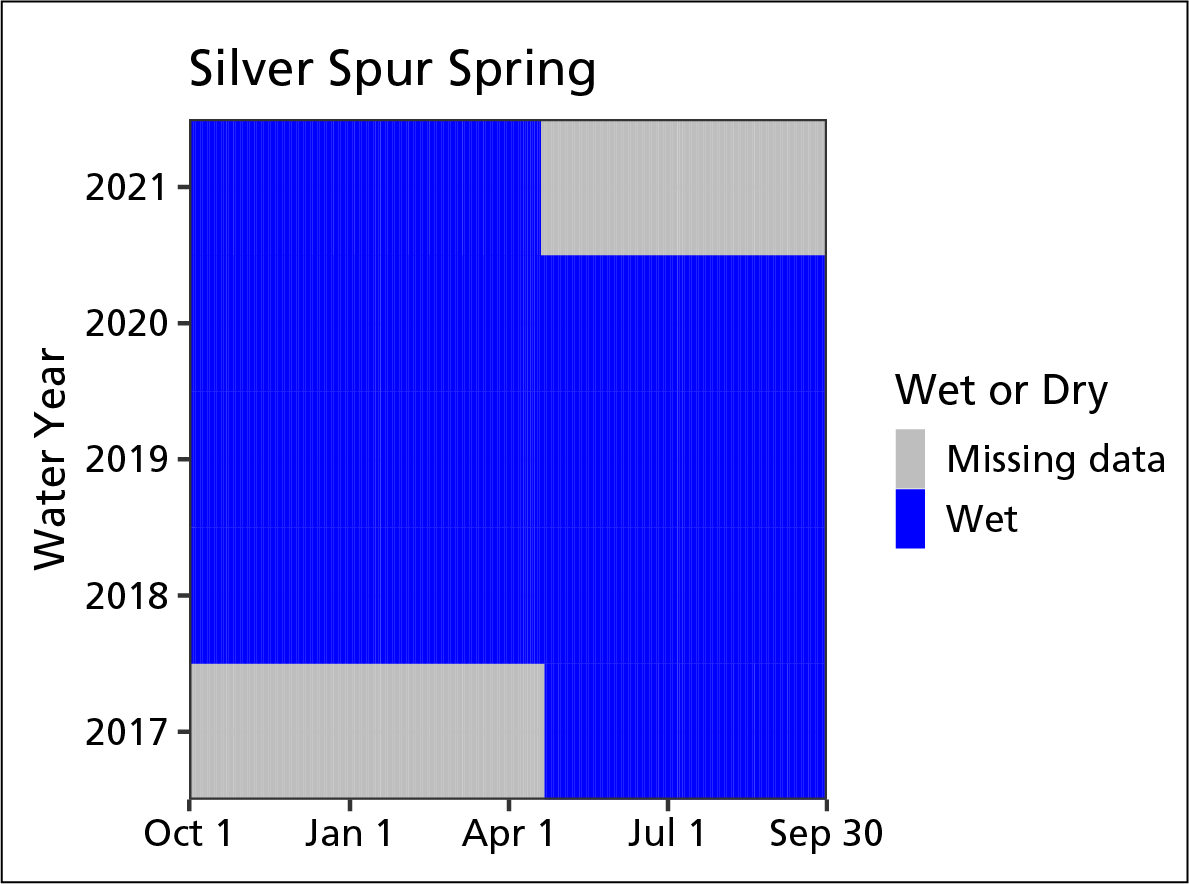 Figure 12. Water persistence in Silver Spur Spring, Chiricahua National Monument.
Figure 12. Water persistence in Silver Spur Spring, Chiricahua National Monument.Water quantity. The WY2021 visit occurred on April 20, 2021. The spring contained water when sampled. Temperature sensors indicated that Silver Spur Spring was wetted (contained water) for 202 of 202 days (100%) measured up to the WY2021 visit (Figure 12). In prior water years, the spring was wetted 100% of the days measured. Unlike in past years (although sampling did not occur in WY2020 due to the COVID-19 pandemic), we could not estimate spring discharge in WY2021, due to the lack of flowing surface water when visited (Table 10).
Wetted extent was evaluated using a method for flowing water. The total brook length was 68 meters (223 ft). Width and depth averaged 124.9 centimeters (49.2 in) and 3.3 centimeters (1.3 in), respectively. The wetted extent and depth of Silver Spur Spring was within the range observed since WY2017, when sampling began (Table 11).
Water quality. Core water-quality and water-chemistry data were collected at the first pool below the orifice, as in past years. A syringe was used to collect the chemistry sample, as the pool was covered in loose leaves and algae. All values were within the range (or less than the minimum detectable change from the range) observed in prior years except for total dissolved solids (Table 12) and chloride (Table 13), which were each just slightly below the range observed in WY2017–2019 (sampling did not occur in WY2020 due to the COVID-19 pandemic). As in some past years, dissolved oxygen indicated hypoxic conditions, perhaps due to decaying organic material.
Table 10. Discharge data (L/min; mean ± SD) for Silver Spur Spring in water year 2021, and a range of values from prior years.
| Sampling location | WY2021 value (Range of prior values) | Prior years measured (# of measurements) |
|---|---|---|
| 001 | cns* (0.01–2.7) | 2018–2019 (2) |
*cns = could not sample
Table 11. Average (± SD) width and depth (cm) of Silver Spur within springbrook length (up to 100 m) in water year 2021, and a range of values from prior years.
| Measurement | WY2021 value (Range of prior values) | Prior years measured (# of measurements) |
|---|---|---|
| Width (cm) | 124.9 ± 82.2 (111.7–126.2) | 2017–2019 (3) |
| Depth (cm) | 3.3 ± 3 (2.3–5.1) | 2017–2019 (3) |
| Length (m) | 67.8 (63.1–79.9) | 2017–2019 (3) |
Table 12. Data on core water-quality parameters for Silver Spur Spring in water year 2021, and a range of values from prior years.
| Parameter | Sampling location | Measurement location | WY2021 value (Range of prior values) |
Prior years measured (# of measurements) |
|---|---|---|---|---|
| Dissolved oxygen (mg/L) | 001 | Center | 2.69 (1.7–7.88) | 2017–2019 (3) |
| pH | 001 | Center | 7.04 (6.84–7.33) | 2017–2019 (3) |
| Specific conductivity (µS/cm) | 001 | Center | 284.7 (288.3–299.3) | 2017–2019 (3) |
| Temperature (°C) | 001 | Center | 16.5 (15.4–19) | 2017–2019 (4) |
| Total dissolved solids (mg/L) | 001 | Center | 185 (187.2–195) | 2017–2019 (3) |
Table 13. Water-chemistry data (mg/L) for Silver Spur Spring in water year 2021, and a range of values from prior years.
| Parameter | Sampling location | Measurement location | WY2021 value (Range of prior values) |
Prior years measured (# of measurements) |
|---|---|---|---|---|
| Alkalinity (CaCO3) | 001 | Center | 140 (105–130) | 2017–2019 (3) |
| Calcium (Ca) | 001 | Center | 28 (24–30) | 2017–2019 (3) |
| Chloride (Cl) | 001 | Center | 1 (2–12) | 2017–2019 (3) |
| Magnesium (Mg) | 001 | Center | 5 (2–8) | 2017–2019 (3) |
| Potassium (K) | 001 | Center | 0.6 (0.9–1.3) | 2017–2019 (3) |
| Sulphate (SO4) | 001 | Center | 1 (2–29) | 2017–2019 (3) |
Authors
Information prepared by Kara Raymond (Southern Arizona Office) and Andy Hubbard, Cheryl McIntyre, and Laura Palacios (Sonoran Desert Network).
